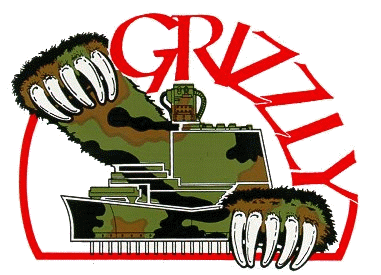 The Fiscal Year 2001 Army budget request included decisions to restructure or "divest" a number of programs in order to provide some of the resources to support its transformation to achieve the ambitious deployment goals outlined in the October 1999 Army Vision. The restructured programs are the Crusader and the Future Scout and Cavalry System. The "divestitures" include Heliborne Prophet (Air), MLRS Smart Tactical Rocket (MSTAR), Stinger Block II, Command and Control Vehicle (C2V), Grizzly, Wolverine, and the Army Tactical Missile System Block IIA. Funding for these programs was reallocated to fund the Army Vision transformation strategy.
The Fiscal Year 2001 Army budget request included decisions to restructure or "divest" a number of programs in order to provide some of the resources to support its transformation to achieve the ambitious deployment goals outlined in the October 1999 Army Vision. The restructured programs are the Crusader and the Future Scout and Cavalry System. The "divestitures" include Heliborne Prophet (Air), MLRS Smart Tactical Rocket (MSTAR), Stinger Block II, Command and Control Vehicle (C2V), Grizzly, Wolverine, and the Army Tactical Missile System Block IIA. Funding for these programs was reallocated to fund the Army Vision transformation strategy.
The GRIZZLY [initially designated the Breacher] is an armored vehicle designed to breach complex obstacles including mines, berms, wire, rubble, and tank-ditches. The GRIZZLY will breach obstacles with minimal preparation creating safe lanes for other vehicles in the dominant maneuver force with little or no loss in momentum. The GRIZZLY's obstacle clearing features include a full-width mine-clearing blade and a powered, extensible excavating arm.
GRIZZLY is a Military Load Class 70 complex obstacle breaching vehicle which will integrate advanced countermine and counter-obstacle capabilities into a single survivable system. GRIZZLY will incorporate a full width Mine Clearing Blade (MCB), Power Driven Arm (PDA) for obstacle reduction and digging and a commander's control station (CCS) (crew compartment). It will have a remote fired 50-caliber machine gun and grenade launched screening smoke for self-defense. GRIZZLY will breach an 600 meter complex obstacle in 21 minutes and breach an antitank ditch in 5 minutes. GRIZZLY will be capable of breaching other types of natural and man made, simple and complex obstacles, creating a lane for vehicles to follow. It will integrate the technologies incorporated in the M1 & M2A3 chassis with the GRIZZLY mission modules. GRIZZLY is designed to provide the Digital Division with mobility support (i.e. counter-obstacle breaching) for Decisive Operations.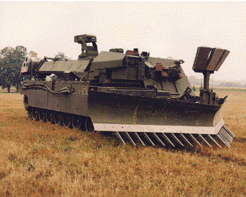 Based on a modified and refurbished M1 Abrams tank chassis, the GRIZZLY will employ armors and many components derived from various members of the Abrams family of tanks. The system employs a two man crew. Its mobility will be comparable to the Abrams Main Battle Tank and the Bradley Fighting Vehicle. The dominant maneuver force will support the GRIZZLY with ongoing direct and indirect fire and air support. The GRIZZLY will be deployed with selected engineer
companies in mechanized battalions, armored cavalry regiments, and heavy brigades. GRIZZLY is employed as an integral part of the M1A2 SEP/M2A3 equipped digital maneuver battalion task force. GRIZZLY as part of the Breach Force and supported by friendly direct and indirect fires, will reduce threat obstacles and create a safe one way passage lane for an M1/M2 equipped force to follow. A GRIZZLY equipped task force can execute breaching operations with minimal preparation and with little or no loss of task force momentum or need for lane proofing.
Based on a modified and refurbished M1 Abrams tank chassis, the GRIZZLY will employ armors and many components derived from various members of the Abrams family of tanks. The system employs a two man crew. Its mobility will be comparable to the Abrams Main Battle Tank and the Bradley Fighting Vehicle. The dominant maneuver force will support the GRIZZLY with ongoing direct and indirect fire and air support. The GRIZZLY will be deployed with selected engineer
companies in mechanized battalions, armored cavalry regiments, and heavy brigades. GRIZZLY is employed as an integral part of the M1A2 SEP/M2A3 equipped digital maneuver battalion task force. GRIZZLY as part of the Breach Force and supported by friendly direct and indirect fires, will reduce threat obstacles and create a safe one way passage lane for an M1/M2 equipped force to follow. A GRIZZLY equipped task force can execute breaching operations with minimal preparation and with little or no loss of task force momentum or need for lane proofing.
Doctrine calls for two lanes per task force with a recommended allocation of two assets to achieve one lane. The GRIZZLY equipped force must provide the task force a near certainty (a 99% probability) of achieving one lane and a high probability (approximately 90%) of achieving two lanes. Assuming that two GRIZZLYs are allocated to each of two lanes, the threshold value of 0.95 results in a 0.90 probability of successfully breaching both lanes and a 0.9975% probability of successfully breaching at least one of the lanes. GRIZZLY will provide a lane allowing 95% of the maneuver task force (threshold) and 99% of the task force (objective) to safely pass, excluding losses due to direct and indirect fires.
GRIZZLY will operate as part of a combined arms task force. The maneuver commander sets the conditions for breaching success through the execution of the Suppress, Obscure, and Secure fundamentals of breaching. Ideally, direct and observed indirect fires on the breach site are eliminated before the GRIZZLY is committed to execute the Reduce fundamental of breaching operations. Force on force combat simulation and threat assessments predict that the most likely direct fire threat faced by the GRIZZLY will come from dismounted teams providing fires on the obstacle and employing handheld anti-tank weapons (RPG type weapons). GRIZZLY is also exposed to indirect fires while conducting the breach. The specified conditions are representative of the type of fire mission expected against the GRIZZLY in the breach. These conditions equate to 60 rounds aimed/targeted at a box approximately 250 meters by 50 meters deep. These parameters will provide the inputs to existing models for development of the specific test parameters to measure compliance with this requirement. It is not intended that testing include the firing of 60 shells. GRIZZLY will provide resistance to perforation of the CCS against a 6-gun artillery battery, firing a variable time fuze, 10 round artillery salvo of 155 mm M107 high explosive with proximity fuze comparable to the M728 from 7,000 meters (threshold). The objective requirement is to provide resistance to top attack munitions.The Breacher program was initiated in FY92 as a result of lessons reinforced during Operation Desert Storm and as a consequence of the deferral of the Combat Mobility Vehicle (CMV) during the Armored Systems Modernization (ASM) restructure. The Army has leveraged the work conducted under the ASM-CMV Advanced Technology Transition Demonstrator (ATTD) program to accelerate the development cycle. A sole-source contract was awarded to United Defense, LP (formerly BMY) in September 1992 for Demonstration and Validation prototypes to be delivered in 4QFY95.
Following a significant increase in the GRIZZLY program's procurement objective to the currently planned 366 units, the Army's Acquisition Executive notified OSD that the Army designated the GRIZZLY program an ACAT II program and a covered system for LFT&E in June 1996. The GRIZZLY was added to the FY97 Annual T&E Oversight List for LFT&E only. This program is not an operational test and evaluation oversight program. The Army briefed a draft LFT&E strategy to DOT&E in April 1996 and received DOT&E approval of a revised strategy in December 1996. Dedicated LFT&E events begin in FY98 and extend through FY01.There was one GRIZZLY test event supporting the LFT&E program during FY97. Testing conducted prior to this most recent effort consisted of developmental and demonstration/validation testing only. That testing, although generating valuable information for the product manager, did not provide relevant data for the LFT&E. A full-up, system-level test employing a prototype chassis was subjected to a mine detonation during FY97. This test challenged a mine clearing blade system that had been redesigned based on FY96 developmental test results. The redesigned mine clearing blade system survived the mine detonation and did perform in accordance with engineering expectations.
The program is in Engineering and Manufacturing Development (EMD) Phase and funded for First Unit Equipped (FUE) in 3QFY04 to 1 CD. Initial Operational Capability (IOC) is 4QFY04. United Defense (UD) finalized their EMD vehicle design 30 Jul 98 and will fabricate two prototypes for delivery to the government in 2QFY00.| MS 0: MS 1: EUE: MS II: LUT: LRIP (MS IIIA): IOT: MS III (TC STD): |
31 Jan 92 13 May 92 29 Feb 96 17 Dec 96 Apr-May 00 Sep 00 3QFY02 3QFY03 |
BASIS OF ISSUE:
| Army Acquisition Objective (AAO)........... | 846 |
| Army Procurement Objective (APO)............. | 366 |
| APO distribution due to budget constraints: | Pending DA Approval |
| 18, En Bns Hvy Div at 12 per
Bn..................... 6, Hvy Div ORF at 1 per Div............................. 1, ACR at 6 per En Co....................................... 7, ENH Bdes at 12 per Bn 4, En Bns Corps (M) at 6 per Bn..................... 1, APS at 12........................................................ TRADOC Training Base................................. |
216 6 6 84 24 12 6 (APG/EPG, FK & FLW) |
| Basis of Issue Plan (BOIP):............................. | 12 per En Bn Hvy Div & Corps (M) 6 per En Co, ACR & SEP Bde |
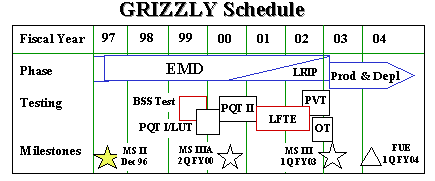
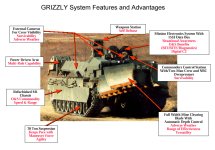
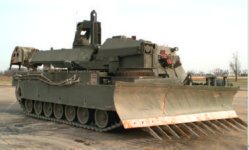
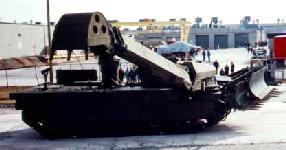
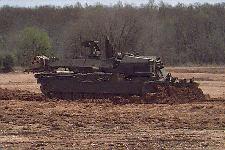
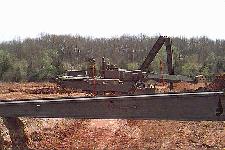
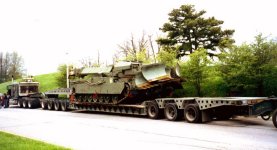

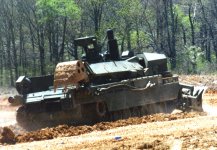
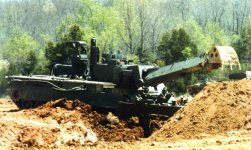

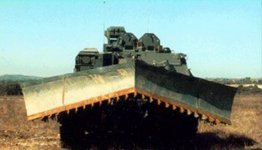
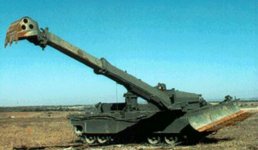
Sources and Resources
- BREACHER (GRIZZLY) Basis of Issue Plan
- The Grizzly: Mobility Support for Force XXI By Lieutenant Colonel Donald P. Kotchman, Wesley I. Glasgow, and Lieutenant Colonel Harry Greene Engineer Bulletin February 1998
- The Grizzly and the Wolverine: Alternatives to an Orchestrated Ballet of Farm Implements By Major Harry GreeneEngineer Bulletin August 1996
- Program Overview: "Why a Grizzly" [2200-KB PDF] presents overview and theoretical operational underpinnings to the need for the Grizzly.
- Product Manager GRIZZLY Homepage
- TSM GRIZZLY Homepage
- grizzly@wes Army Waterways Experiment Station
FAS |
Military |
DOD 101 |
Systems |
Land Warfare ||||
Index |
Search |
Join FAS
http://www.fas.org/man/dod-101/sys/land/grizzly.htmMaintained by Robert Sherman
Originally created by John Pike
Updated Thursday, May 04, 2000 4:15:49 PM


